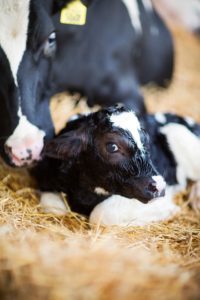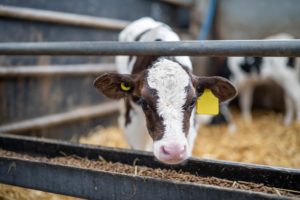1) Calves should only be fed up to 2 litres per meal
As the calf’s rumen develops it becomes less desirable for the milk to enter as it can change the pH and microbiota, causing digestive problems and potentially reducing growth. Many farmers assume the capacity of the abomasum is around 2 litres and that feeding more risks abomasal overload with liquid feed entering the rumen. However, the science does not back this up; higher rates of feeding can be achieved even if only feeding twice a day.
Data from Ellingsen et al. (2016) showed three-week-old calves will voluntarily consume up to 6.8 litres in one meal without milk entering the rumen or any indications of abdominal pain or discomfort. Other data confirms that the abomasum can accommodate much more than 2 litres of fluid. Calves slow down the rate of abomasal emptying to control blood glucose, so exaggerated rises in blood glucose and associations with insulin resistance are not a problem when feeding larger meals.
2) Feeding more milk solids costs more
Feeding more milk solids costs more than starter feeds, but the return on investment needs to be considered when evaluating overall cost-effectiveness. Feed conversion efficiency is much higher during the first weeks of life than at any other point in the growth cycle. This economic benefit is largely due to the link between improved growth and the associated benefits for reproductive and lactation performance.
Professor Àlex Bach showed that every 100g of average daily gain in the first two months of life, gives approximately 250kg of extra milk in the first lactation. Reproductive performance improves as faster maturing heifers can be bred earlier. Increased longevity means cows produce more milk and are more resilient to disease, staying in the herd longer reducing your cull rate.
3) Cow’s metabolism cannot be permanently changed
Variations in metabolism mean some cows produce more milk whilst others are more prone to disease, but it is a misconception that these variations are only determined by genetics.
Metabolic Programming means external factors can alter gene expression over time without affecting the gene sequence. This underpins the LifeStart heifer rearing approach, which optimises calf nutrition in the first 60 days to achieve greater performance later in life by maximising their genetic capacity.
The first two months of life is the optimal time to programme the metabolism. Research shows a high plane of nutrition improves calf growth rates and organ development and has a long-term influence on many of the metabolic pathways that underlie productive processes as well as the development of the immune system and the gut microbiome.
4) Elevated planes of nutrition has no effect on health post-weaning
It seems logical that if you feed calves more, they will grow more. But what is the effect on their health? Nutrition can influence the development of the gastrointestinal tract and its immunity, both vital for short term health and longer-term resilience to disease. In one study Holstein calves fed a higher plane of nutrition of milk solids had better hydration and faecal score improvement following Cryptosporidium parvum challenge at three days of life. (Ollivett et al., 2012).
Another study looking at effects on post-weaning health; cows previously fed a low plane of nutrition pre-weaning had a decreased ability to kill E.coli a month after weaning, compared to those fed a high plane (Ballou, 2012). Similarly, Ballou et al (2015) showed that calves fed higher levels of milk solids before weaning had improved resistance when challenged with Salmonella one month after weaning. The data suggest that feeding a high plane of nutrition pre-weaning can improve immune development and the health of calves before and after weaning if implemented correctly.
5) Feeding elevated planes of nutrition gives calves scour
Many farmers are reluctant to feed a higher plane of nutrition believing that the increased milk solids cause scouring. However, studies show that looser faeces when feeding more milk solids does not usually mean a calf has a disease. Liang et al. (2016) showed although calves fed a higher plane of nutrition had higher faecal scores than those fed a restricted diet, there was no difference in the faecal dry matter content. There was no difference in energy digestion and protein digestion and retention were higher in those calves fed more milk solids.
The benefits of a high plane of nutrition for average growth, development, resilience to disease and lactation performance are well documented. Nutritional diarrhoea may occur if certain nutrients like lactose are oversupplied so it is vital to focus on the quality and formulation of the milk replacer to ensure it is suitable to feed at high levels.
To help improve your calf rearing enterprise, please get in touch on 0800 756 2787, or click HERE.
